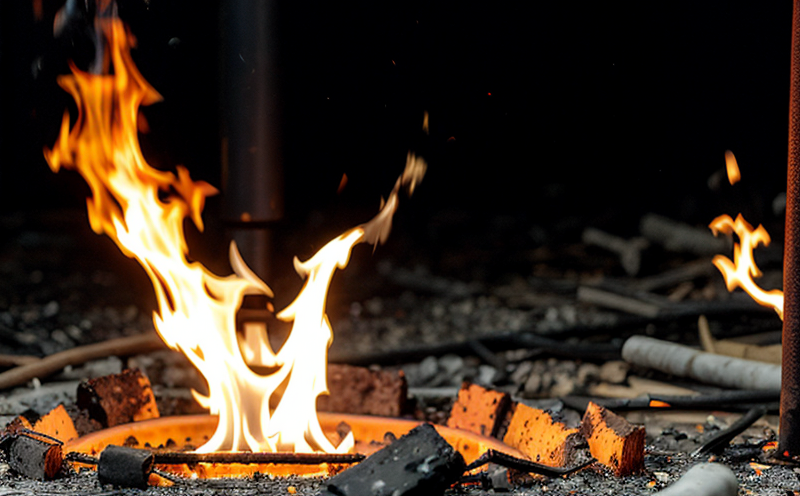EN 71-2 Spark and Flame Producing Toy Safety Test
The EN 71-2 Standard, titled "Plastics in Toys—Part 2: Flammability," is a critical component of the European Union's safety regulations for toys. This standard ensures that materials used in toys do not pose fire hazards, particularly when exposed to sources of ignition like matches or lighters. The spark and flame-producing toy safety test under EN 71-2 aims to assess whether a toy can produce sparks or flames under specific conditions.
The testing procedure is designed to simulate real-world scenarios where a child might come into contact with the toy, such as playing near fire sources. This standard applies not only to materials like plastics but also to other components that could potentially ignite and cause harm if they spark or flame during playtime.
Test Procedure:
- The test involves exposing a specified area of the toy to a source of ignition for 10 seconds.
- The time taken for the material to extinguish after ignition is measured.
- If any sparks or flames are observed within this period, it indicates non-compliance with EN 71-2 standards.
Specimen Preparation:
- All parts of the toy that could come into contact with a child's skin during normal use should be tested.
- The test is conducted on both sides of any multi-sided part to ensure comprehensive evaluation.
- For complex toys, multiple samples may need to be taken from different areas.
Instruments and Equipment:
- A spark igniter or flame source that meets the specifications in EN 71-2.
- A timer to measure the duration of ignition.
- Environmental control facilities to maintain consistent temperature and humidity levels during testing.
The results of this test are crucial for manufacturers who wish to ensure their products meet international safety standards. Compliance with EN 71-2 is not only a legal requirement but also demonstrates a commitment to the well-being of children, enhancing brand reputation and marketability.
| Industry | Application |
|---|---|
| Toys & Games | Evaluating safety standards for materials used in toys and games. |
| Childcare Products | Determining the flammability of fabrics and plastics used in infant products like strollers and cribs. |
| Park Playgrounds | Assessing safety hazards posed by materials used in playground equipment. |
The test results can influence product design, choice of materials, and overall manufacturing processes. By adhering to EN 71-2 standards, manufacturers can avoid potential legal issues and ensure their products are safe for use.
Industry Applications
The EN 71-2 Spark and Flame Producing Toy Safety Test is widely applicable across various industries. Here are some specific examples:
- Toys & Games: Ensuring that materials used in toys do not produce sparks or flames when exposed to ignition sources.
- Childcare Products: Evaluating the flammability of fabrics and plastics used in infant products like strollers, cribs, and baby carriers.
- Park Playgrounds: Assessing safety hazards posed by materials used in playground equipment. This includes ensuring that any spark-producing materials are safely contained or removed.
| Industry | Application |
|---|---|
| Toys & Games | Evaluating safety standards for materials used in toys and games. |
| Childcare Products | Determining the flammability of fabrics and plastics used in infant products like strollers and cribs. |
| Park Playgrounds | Assessing safety hazards posed by materials used in playground equipment. |
The test is particularly important for industries that target young children, as it helps protect them from potential fire hazards. Compliance with this standard can also enhance the reputation of these companies and improve customer trust.
Customer Impact and Satisfaction
The implementation of EN 71-2 Spark and Flame Producing Toy Safety Test significantly impacts customers by enhancing their confidence in the safety of products they purchase. Compliance with this standard ensures that toys and other related products do not pose a fire risk, which is especially important for young children who may interact with these items.
- Safety: Customers can rest assured knowing that the products meet international safety standards.
- Reputation: Brands that comply with EN 71-2 are seen as responsible and trustworthy, which positively impacts customer loyalty and satisfaction.
- Marketability: Compliance with this standard can lead to increased sales by attracting parents who prioritize product safety for their children.
The results of the test play a crucial role in shaping consumer perception. A positive outcome indicates that the toy or related item meets strict flammability and ignition standards, thereby increasing customer trust and satisfaction. This is particularly important given the global nature of the toy industry, where products are sold across different countries with varying safety regulations.
Environmental and Sustainability Contributions
The EN 71-2 Spark and Flame Producing Toy Safety Test contributes to environmental sustainability by ensuring that toys are produced using materials that do not pose a fire risk when exposed to ignition sources. This standard helps minimize the likelihood of accidents, which can lead to unnecessary waste and clean-up efforts.
The test also encourages manufacturers to use safer alternatives in their product design and development. By reducing the need for recalls due to safety concerns, this standard indirectly supports sustainable practices by minimizing resource consumption and energy use associated with production and distribution.
- Reduction of Accidents: Ensuring that toys do not produce sparks or flames reduces the risk of accidents, which can lead to fewer waste disposal issues.
- Sustainable Material Use: Manufacturers are encouraged to choose safer materials for their products, contributing to overall environmental sustainability.
The standard's focus on safety also promotes responsible sourcing and manufacturing practices, further enhancing its positive impact on the environment.





